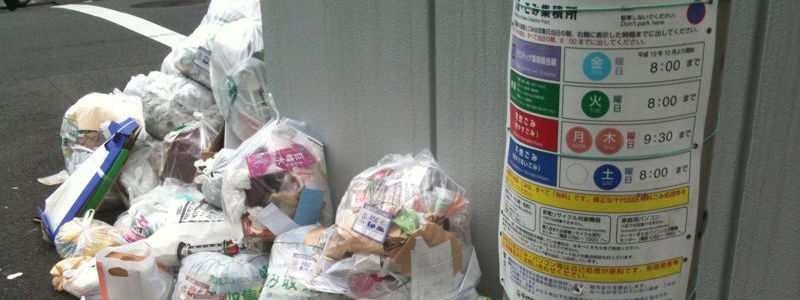Garbage is separated by type and collected at specific locations on specified days. There are broadly 6 categories:
- burnable garbage (燃えるごみ / 可燃ごみ, moeru-gomi / kanen-gomi),
Kitchen waste, tissues, scrap paper, rubber products, leather products, CDs, videotapes, clothing, disposable diapers, cooking oil, plastic containers that cannot be washed
Disposal: Put out on the morning of collection day in clear plastic bags.

- unburnable garbage (燃えないゴミ / 不燃ごみ, moenai-gomi / hunen-gomi),
Glass (other than bottles and jars), metals, ceramics, spray cans, gas canisters, lighters, small electronics, electric and fluorescent light bulbs.
Disposal: Put out on morning of collection day in clear plastic bags, labeled with contents.

- Plastic garbage (プラスチック),
Cleaned out plastic food containers, Styrofoam, plastic bags and sheeting, hangers, toothbrushes, straws etc.
Disposal: Put out on the morning of collection day in clear plastic bags.

- Food and Drink Recyclables (ペットボトル・ビン・カン, pet bottles, glass bottles, cans)
Plastic (pet) bottles, food and drinks cans, glass bottles and jars. Caps, lids and labels should be removed and disposed of in the appropriate category.
Disposal: Specialized containers are placed in streets the day prior to collection – blue net bags for plastic bottles, yellow crates for glass containers and blue crates for cans.

- Paper and Cardboard (新聞・雑誌・段ボール、Shinbun, zassi, danbouru),
Newspapers, magazines, papers and cardboard (including clean cardboard food and drinks cartons).
Disposal: Sort by type, bind with string and place loose outside at designated collection points.

- and other garbage including bulky refuse (粗大ごみ, sodai-gomi).
Furniture, bulky bedding, medium and large appliances (excluding refrigerators, washing machines, computers, TVs and air conditioners), bicycles etc.
Disposal: Oversized garbage in most of the 23 wards area of Tokyo is handled by the Large Sized Waste Reception Center (call: 03-5296-7000 for Chuo, Bunkyo, Shibuya, others: https://sodai.tokyokankyo.or.jp/Sodai/V2Index/0/1). In Shinagawa, Nakano, Meguro, Setagaya and Nerima wards, and areas outside of the 23 wards, oversized garbage is handled by the local municipal office. Set up a date for the collection and describe the type and size of item you wish to dispose of, either by phone or in person. Fees for collection are paid by buying disposal stickers up to a value determined by the size and type of the item. If you call to arrange the disposal, you can buy these stickers at a convenience store. Place the stickers on the item and put it outside on the day agreed upon. Disposal for home appliances not handled as oversized waste can be arranged for a fee, either through the original store of purchase or through a private recycling company.

Depending on where you live, you may have to classify your garbage into smaller sub-groups. Even within Tokyo, rules for separation are not consistent – some areas collect plastic packaging and containers as recyclables, while others treat them as burnable garbage. As a rule, recyclables should be disposed of empty and clean, with plastic labels and caps removed from pet bottles.
For descriptions on recycle marks on products, see the list of Garbage Marks below.
For other large and irregular garbage like furniture, electrical or household appliances, you will need to arrange for the disposal and pay a fee. Sometimes the store where you bought your electrical goods can collect them.
Inquire at your local municipal office for garbage sorting rules, collection schedules, and large size garbage disposal information.
Waste Collection Services
Here are some common waste collection services.
Garbage Marks
The below marks are displayed on everyday items. Please refer to your local municipality for garbage separation and rules.
 |
Paper
Displayed on packages etc. made from paper, and is usually classified as burnable garbage. |
 |
Plastic
Displayed on plastic products. Garbage classification largely differs among municipalities. |
 |
Aluminum
Seen on beverage cans, and other aluminum products. Usually collected as recyclable garbage. |
 |
Steel
Seen on beverage cans, and other steel products. Usually collected as recyclable garbage. |
 |
PET
Commonly seen on plastic bottles of soft drinks, oil, condiments, etc. Recyclable garbage. |
 |
Cardboard
Displayed on cardboard boxes (“Danboru” in Japanese). Recyclable garbage. |
 |
Carton
Displayed mainly on milk cartons and juice cartons. Wash, cut open, dry, and recycle. |
